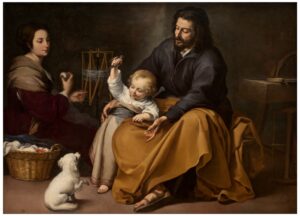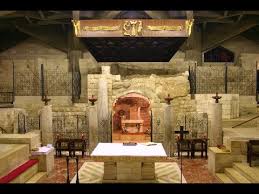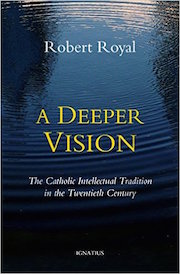The marriage problem among Catholics, historically, was that the wife, out of fear of childbearing, showed “the coldness of Chloe,” while the man for good and bad reasons strongly desired his wife: a standoff leading to anger, frustration, and recrimination.
Child-bearing was indeed something to be afraid of. Parish records in England show that around 1850, for example, the mother died in one out of twenty births. If the husband was risking his life at war or in a dangerous job for the sake of his family, there was parity. But otherwise one might at least raise a doubt about the quality of love which asks for a potential sacrifice of the life of the other but not oneself.
The language, “husbands, love your wives as Christ loved the Church, and gave himself up for it,” therefore, raised a serious challenge. (Eph 5:25) How exactly was he to do that?
There are lots of reasons for Chloe to be cold, or at least cool, even when maternal mortality has dropped, as now, to 1/50th of the risk it used to have, such as: fatigue and worry, persistent exhaustion, the need for recovery or a break, a different biology and different imperatives – and perhaps even a more proportioned view of sex.
After all, the relationship to children, the greater good surely, will be clearer to the wife. And there are many more causes from the culture for the husband to feel himself frustrated and aggrieved, obviously. In natural and sacramental marriage, then, the marriage problem remains.
Probably “theology of the body” – in its popular forms – aggravates the problem, by creating unrealistic expectations. Marriage is not a repeated reenactment of the ecstasy of the internal life of the Trinity. Natural Family Planning does not itself solve anything, but draws greater attention to the problem, because it rules out relations just at the time when the wife is most likely to be drawn to them – which can even seem perverse, hardly “natural.”
Putting the best face on it, we might re-describe the marriage problem as the tension between romance and marriage. Romance outside of marriage has a way of turning itself into sex. One sad solution but so common as almost to characterize entire cultures (um, France) was the mistress.
In less hypocritical but more deceitful, yet “sincere,” societies, such as ours, the husband might favor a series of affairs. Or pornography will appear to be the way out – promiscuity and porn in many cases simply being the easy path, the husband returning to old habits from college.

In simpler times, say, around 1950, after Catholics got married, they regarded themselves as fixed in that marriage for life, not for any particular reason except that the Catholic Church in its wisdom, apart from all the other Christian “denominations,” insisted on it. These Catholics of course experienced all of the tensions of what I am calling the marriage problem. But it was a problem you were stuck with. You didn’t complain and you gritted it out somehow.
Now present them with The Pill. Unlike other methods, it works invisibly. One doesn’t seem to be deliberately doing anything to block conception in using it. It requires no choice in the moment. It comes with the calm assurance of Science, the same people who gave us the polio vaccine.
Then consider this fact about anger: it is easily transferred. What could be more arbitrary, unreasonable, and cruel, than that a Church – that “expert in humanity”! – which forbids divorce, and locks us into this relationship (understand that each couple facing the marriage problem thinks that they are the only ones), now for incomprehensible reasons tells us that we cannot use this Scientifically-Recommended, “obviously” suitable solution to our problems?
What exactly does a priest say to a couple who week after week complains to him angrily in this way? They are married after all, and he has no experience. What did the “Birth Control Commission” appointed by St. Pope Paul VI do, when couples from the United States lobbied by compiling story after story of couples whose marriage, they said, was on the rocks because of the inevitable frustrations of following the Church’s teaching?
They mainly caved, of course. Faced with anger, if one is kind, one caves. Yet the saint who was pope did not, nor did the saint who was on the minority side of the Commission.
Of course, everything unravels once artificial birth control is accepted. Marriage changes its meaning. Courtship disappears. Abortion, already implicit in contraception and explicit in some methods, follows immediately. People in same-sex relationships understandably look on and ask why what is good for these others isn’t also good for them?
Looking back at the consequences, it can seem now as if the couples who were angrily lobbying the Vatican wanted all of society to be overturned to solve their problem – that a private good would take precedence over the common good.
And in that crisis and strain the Archbishop of Krakow crafted his lectures on Love and Responsibility. His goal, he said, was to show how love as eros finds a place in love as caritas – to solve the marriage problem, the tension between romance and marriage. If the family is the basic cell of society and marriage the foundation of the family, then it is not too much to say that this teaching is the main contribution of his pontificate for the Church – and for humankind.
Like all other genuine problems, the marriage problem has no natural solution. We can avoid it – we can “destroy the mystery,” as other ages tried to avoid the Incarnation or Trinity by asserting only half of the truth. That is the spectacle we see today, in the Synod on Synodality, just as outrageous as other acts of denial in the history of the Church.
Or we can accept that marriage offers no genuine joy except what comes through the Cross, and rediscover and embrace that Cross daily.
__________















